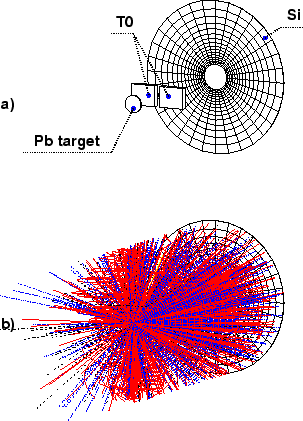The Si pad array, installed 10cm downstream from the target
inside the first dipole magnet, measures
ionization energy loss of charged particles
(![]() ) in its 512 300
) in its 512 300 ![]() m thick Si pads.
The detector covers
m thick Si pads.
The detector covers
![]() and
and ![]() azimuthally.
Radially, the pads are arranged to be fragments of 16 rings with equal
pseudorapidity coverage (see Fig.3.2 ).
Azimuthally, they constitute 32 sectors with equal angular coverage.
azimuthally.
Radially, the pads are arranged to be fragments of 16 rings with equal
pseudorapidity coverage (see Fig.3.2 ).
Azimuthally, they constitute 32 sectors with equal angular coverage.
![]() -electrons, produced by the
-electrons, produced by the ![]() nuclei of the beam especially copiously
in
the target, are swept away to one side by the magnetic field of the first dipole
(
nuclei of the beam especially copiously
in
the target, are swept away to one side by the magnetic field of the first dipole
(
![]() in the strong field setting).
Because the energy spectrum of
in the strong field setting).
Because the energy spectrum of ![]() -electrons is dominated by low energies,
this sweeping effect of the field leaves the other half relatively clean and
useful for multiplicity analysis.
-electrons is dominated by low energies,
this sweeping effect of the field leaves the other half relatively clean and
useful for multiplicity analysis.
 |
The charge collection time
for a 300 ![]() path length in the Si is typically 10-20 ns
[33].
AMPLEX has 600 to 800 ns peaking time [30].
Duration of an SPS spill was about 4.7 s, and NA44 was typically operating
at (2-4)
path length in the Si is typically 10-20 ns
[33].
AMPLEX has 600 to 800 ns peaking time [30].
Duration of an SPS spill was about 4.7 s, and NA44 was typically operating
at (2-4)
![]() beam particles per spill.
The thickest Pb target used had 0.034 interaction probability for the Pb beam.
Therefore, the typical rate of minimum bias interactions was always
below 31 kHz, i.e. on average 32
beam particles per spill.
The thickest Pb target used had 0.034 interaction probability for the Pb beam.
Therefore, the typical rate of minimum bias interactions was always
below 31 kHz, i.e. on average 32 ![]() per interaction, and pile-up was
highly unlikely.
per interaction, and pile-up was
highly unlikely.
The data from the detector was used
in the texture analysis of the hadron production (using the data recorded in
1994),
and in the analysis of meson production in the ![]() collisions to normalize
particle yields (the 1995 data).
In the latter case, the same detector was used in its second running period, so
that radiation damage was noticeable.
In both cases, more information on the detector and its characteristics
will be given in the appropriate sections.
collisions to normalize
particle yields (the 1995 data).
In the latter case, the same detector was used in its second running period, so
that radiation damage was noticeable.
In both cases, more information on the detector and its characteristics
will be given in the appropriate sections.